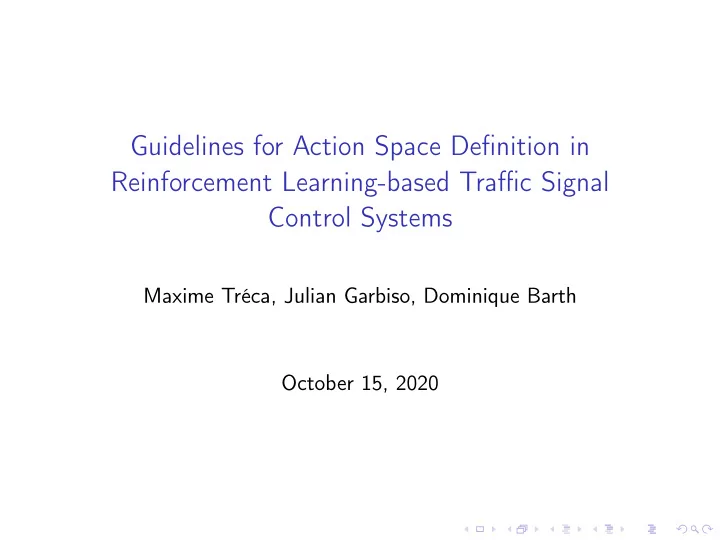

Guidelines for Action Space Definition in Reinforcement Learning-based Traffic Signal Control Systems Maxime Tréca, Julian Garbiso, Dominique Barth October 15, 2020
Outline I - Reinforcement Learning Applied to Traffic Signal Control II - Model III - Guidelines V - Conclusion VI - Bibliography
I - Basics of Reinforcement Learning s t Agent Environment a t r t Reinforcement Learning methods aim at learning from the feeback of the state-action-reward loop: ◮ By testing all possible state / action combinations ◮ By storing the resulting rewards of these combinations ◮ By establishing a policy using this stored data
I - Q-Learning Q-learning is a Reinforcement Learning algorithm developed by Watkins [2]. ◮ The agent records and updates an estimation of the payoff of each state/action pair it encounters in a Q-table. a 1 . . . a n s 1 v s 1 , a 1 . . . v s 1 , a n . . . . . . . . . . . . s m v s m , a 1 . . . v s m , a n ◮ An iterative formula is used to update this estimation: Q ( s t , a t ) ← ( 1 − α t ) Q ( s t , a t ) + α t ( r t + γ max Q ( s t + 1 , a t ))
I - Reinforcement Learning applied to Traffic Signal Control Reinforcement Learning (RL) algorithms have been applied to Traffic Signal Control (TSC) since the early 2000s: ◮ Wiering [3]: first use of Q-learning at the intersection level to decrease vehicle waiting time on a road network. ◮ El-Tantawy [1]: MARLIN algorithm, which coordinates multiple RL-based agents using real traffic data.
I - Problem Statement In the paper cited above, agent actions are either: ◮ Phase-based : the agent sets the entire length of the green phase. ◮ Step-based : the agent decides whether to extend the current phase every k steps. → No action space definition comparison in the litterature.
II - Experimental Framework ψ 2 ◮ We consider a single intersection ◮ State : � ψ i , d i , n 1 , n 2 � ◮ Action is either: ψ 1 ψ 1 ◮ The length of ψ i ◮ Extend ψ i by k steps ◮ Reward: � ω t + a − � ω t ψ 2
II - Traffic Generation λ + τ ◮ Two Poisson processes ◮ λ + τ = 0.5 λ λ ◮ τ measures the un-evenness of traffic λ + τ
II - Simulation Settings ◮ SUMO microscopic traffic simulator. ◮ 100 successive iterations of 10 000 steps each ◮ We mesure total vehicular delay over each iteration. ◮ Results normalized over 50 distinct runs.
III - Guideline #1 - Step-based v. Phase-based Methods τ Fixed Phase Step (Best) Step (Worst) 0.0 3 . 617 2 . 672 2 . 053 2 . 473 0.1 4 . 070 2 . 746 1 . 956 2 . 595 0.2 4 . 603 3 . 070 1 . 977 2 . 570 0.3 7 . 773 4 . 582 2 . 032 2 . 531 0.4 6 . 807 5 . 773 2 . 088 2 . 216 0.5 18 . 329 3 . 240 1 . 994 2 . 473 Table: Average vehicle waiting time after convergence per agent type and traffic parameter τ (in 10 3 seconds).
III - Guideline #1 - Step-based v. Phase-based Methods · 10 4 Fixed 5 Phase Step n = 5 Total Waiting Time (s) Step n = 15 4 3 2 0 10 20 30 40 50 60 70 80 90 100 Simulation Runs Guideline #1 Step-based methods are always preferable to phase-based ones.
III - Guideline #2 - Decision Interval Length τ k = 1 k = 5 k = 10 k = 15 k = 20 0.0 0 4.86 10.29 22.37 27.81 0.1 0 4.17 7.20 23.96 30.15 0.2 0 0.45 5.49 22.68 31.03 0.3 3.04 0 4.38 11.02 26.39 0.4 9.53 0 2.74 11.09 7.84 0.5 22.12 0.56 0 13.60 3.33 Table: Percentage difference with respect to the optimum average vehicle waiting time (marked as 0) for step-based methods by action interval value k and traffic scenario τ Guideline #2 Very short intervals between decision points are preferable for uniform traffic while slightly longer intervals are preferable for skewed traffic demand.
III - Optimal Interval Length τ k = 1 k = 5 k = 10 k = 15 k = 20 0.0 0 4.86 10.29 22.37 27.81 0.1 0 4.17 7.20 23.96 30.15 0.2 0 0.45 5.49 22.68 31.03 0.3 3.04 0 4.38 11.02 26.39 0.4 9.53 0 2.74 11.09 7.84 0.5 22.12 0.56 0 13.60 3.33 Table: Percentage difference with respect to the optimum average vehicle waiting time (marked as 0) for step-based methods by action interval value k and traffic scenario τ Guideline #3 Defining longer intervals between successive decision points (from 5 to 10 seconds) yields satisfactory to optimal results for step-based agents.
V - Conclusion Issue: No in-depth comparison of step-based and phase-based action spaces fo RL-TSC. Conclusions: ◮ Step-based is always preferable ◮ Shorter action interval for uniform traffic demand ◮ Optimal and realistic step interval between 5 and 10 seconds.
V - Conclusion ◮ Results only on a simple 4-street intersection ◮ However, guidelines validated on a NEMA -type intersection.
References I Samah El-Tantawy, Baher Abdulhai, and Hossam Abdelgawad. Multiagent reinforcement learning for integrated network of adaptive traffic signal controllers (marlin-atsc): methodology and large-scale application on downtown toronto. IEEE Transactions on Intelligent Transportation Systems , 14(3):1140–1150, 2013. Christopher JCH Watkins and Peter Dayan. Q-learning. Machine learning , 8(3-4):279–292, 1992. MA Wiering. Multi-agent reinforcement learning for traffic light control. In Machine Learning: Proceedings of the Seventeenth International Conference (ICML’2000) , pages 1151–1158, 2000.
Recommend
More recommend